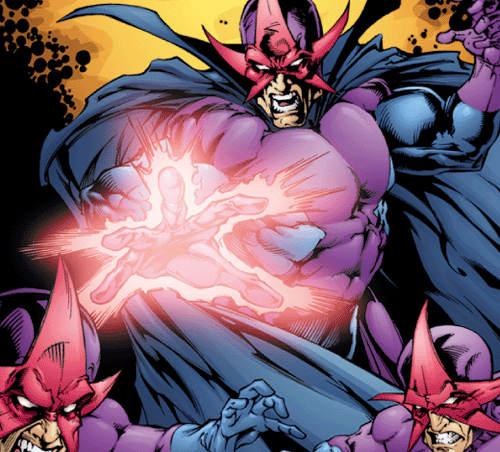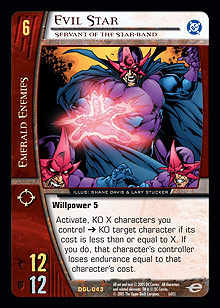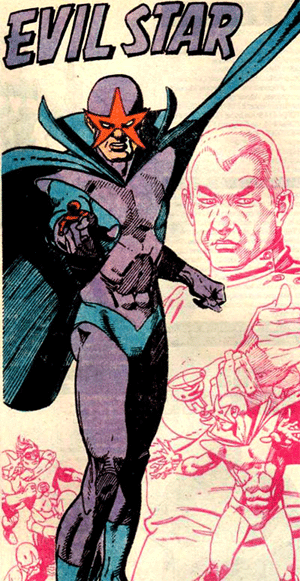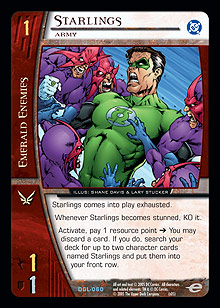
The Donkey Club fulfilled a few fantasies at Pro Circuit San Francisco. They displayed the most incredible team skills Vs. System has ever seen and placed four separate members in the Top 8. They manipulated the strategies of their chosen Trading Card Game so totally that it will never be played the same way again. And, most personally satisfying to me, they did it with Evil Star. 
The Ivy League deck that The Donkey Club played was very much like a dream in many ways. It was a nightmare for its opponents. It did things that normal daylight games of Vs. System don’t do. It also did things that it won’t be able to do again. Justice League of Arkham, the cornerstone card in this discard/control strategy, will be banned from tournament play beginning July 1, 2006. Ivy League will soon be a distant memory in the collective consciousness of the community. It did, however, create one of the most intriguing storylines ever.
 Let’s start with the human drama that kicks up whenever a big tournament rolls around. The top teams in the game have secret tech that they develop through extensive private playtesting. They keep it concealed as well as they can. In this case, the discard design was so completely different from any other method of victory that it was set to be a disastrous shock for its unsuspecting opponents. The hidden agenda of the Ivy League deck had been kept under wraps quite well until a week before Pro Circuit San Francisco, at least on the public forums. Then it started to leak.
Let’s start with the human drama that kicks up whenever a big tournament rolls around. The top teams in the game have secret tech that they develop through extensive private playtesting. They keep it concealed as well as they can. In this case, the discard design was so completely different from any other method of victory that it was set to be a disastrous shock for its unsuspecting opponents. The hidden agenda of the Ivy League deck had been kept under wraps quite well until a week before Pro Circuit San Francisco, at least on the public forums. Then it started to leak.
There was an article about a discard deck in one place. There was a forum or two in another. All of a sudden, the cat was out of the bag, and players began to think about putting Black Cat, Master Thief into their decks to steal a win or two from anyone bringing the deck that relied on a 4-cost plot twist. The Donkey Club had already put all its eggs in the Ivy League basket, and now it looked like everyone else would be aware of it.
The tournament began. When the first-ever Silver Age metagame was analyzed, the Justice League of Arkham “secret tech” was being played by more people than any other strategy in the room. The Donkey Club had twenty different copies of its private build in the field, and there were twenty-one other players running different versions. Whether the others had simultaneously generated the idea or actually received the information from within the Donkeys’ own stables will never be known. But we can be sure of one thing: the Ivy League deck was sharply different from its imitators. It was much better, both in flavor and in function.
The basic plan of the Ivy League deck went like this:
Turn 1: Play Archangel, Angel to fetch X-Corp: Amsterdam, which will be turned into Justice League of Arkham. This also allows one future weapon to be added to the KO’d pile.
Turn 2: Play Poison Ivy, Deadly Rose, who is quickly becoming one of the most powerful characters in the game. She facilitates the customization of the resource row and makes it possible to manipulate the KO’d pile completely.
Turn 3: Play Dr. Light, Master of Holograms, usually bringing a discarded Hope into play to get a double play out of the Justice League of Arkhams in the resource row.
Turn 4: Play some combination of Yellowjacket; Beetle, Armorsmith; Kyle Rayner, Last Green Lantern; or Deadshot, Floyd Lawson, depending on the opposing board. This is, of course, preceded by enough forced discards to remove the other player’s hand completely.
Turn 5 really showed the skill of the deck, as a small force of the above characters would jump in and out of the KO’d pile and stabilize into a board presence. That was the thing that thrilled me most about this historically temporary steamroller of a strategy.
Turn 6: Play Evil Star. Perhaps the most brilliant character choice in Pro Circuit history, this card has been almost completely ignored throughout its entire life. In Ivy League, it was a perfect fit.

That’s all you get for the strategy of the deck. Evil Star is about to set me off into a flight of fantasy and mythos. Even though the Justice League of Arkham discard method is about to be banned, you would still do well to study the match reports from Pro Circuit San Francisco further to see The Donkey Club in action with all that KO’d pile manipulation. Those card combinations can almost perform the impossible, which is exactly what decks like this do to the comic mythology of the characters involved.
Each Vs. System deck could be considered a story in itself. There are characters and plot twists and locations and equipment, just like a comic book. The best part? You and I get to decide who gets to be in each tale. We get to custom-tailor our myths.
The official legend of Evil Star is intense enough by itself. A mad scientist who created a way to live forever by absorbing stars, this guy laughed as his family aged and died while he stayed young. His powerful “starband” technology can transmute the power of the stars into destructive weapons and hard light constructs. Evil Star loves blowing things up. When the people of his home planet rose up against him, he annihilated all six million of them and lived there by himself.

 Getting lonely fast, Evil Star created a crew of Starlings to help him on his evil missions. They were very powerful little extensions of his being, they were completely under his control, and they were impossible to kill. If they ever received a lethal blow, they would simply disappear and be replaced by two new Starlings. They held plenty of ability and were a big nuisance to Hal Jordan for a long time. One time, Evil Star took a trip to Earth because the star nearest his own planet had been drained of its power. He found out that Hal Jordan was also visiting our planet and he sent the Starlings over to Hal’s motel room to steal the portable power battery that was brought to recharge the Green Lantern ring. When the handful of Starlings saw how heavy the battery was, they decided to kill each other off until they had a sizable enough swarm to carry it back to Evil Star. That is simply amazing stuff, especially when it translates so well to Vs. System.
Getting lonely fast, Evil Star created a crew of Starlings to help him on his evil missions. They were very powerful little extensions of his being, they were completely under his control, and they were impossible to kill. If they ever received a lethal blow, they would simply disappear and be replaced by two new Starlings. They held plenty of ability and were a big nuisance to Hal Jordan for a long time. One time, Evil Star took a trip to Earth because the star nearest his own planet had been drained of its power. He found out that Hal Jordan was also visiting our planet and he sent the Starlings over to Hal’s motel room to steal the portable power battery that was brought to recharge the Green Lantern ring. When the handful of Starlings saw how heavy the battery was, they decided to kill each other off until they had a sizable enough swarm to carry it back to Evil Star. That is simply amazing stuff, especially when it translates so well to Vs. System.In our game, Evil Star can use any other character card as a substitute Starling for flavor. That is a heavy trick. It had always confounded me to see this insane KO ability ignored. When I Googled Evil Star and his Starlings in my research, I found out that my Tiniest Threat article from December is the only major mention of the card within the community. It is almost the only mention of Evil Star at all.
 It was a strangely satisfying surprise to see such skilled strategists as The Donkey Club playing with one of my favorite fantasy characters. The Ivy League deck allowed the mad scientist to experiment on a motley crew of mini-myths that would never be caught dead together in the comic books. Turning Marvel characters such as Archangel, Yellowjacket, and Beetle into Starlings on Day 3 of a Pro Circuit? Yes, please. Finishing with Psycho-Pirate on turn 8? That is beyond my wildest dreams and much more than I would ever ask for. Thank you, Donkey Club—it was really fun to watch.
It was a strangely satisfying surprise to see such skilled strategists as The Donkey Club playing with one of my favorite fantasy characters. The Ivy League deck allowed the mad scientist to experiment on a motley crew of mini-myths that would never be caught dead together in the comic books. Turning Marvel characters such as Archangel, Yellowjacket, and Beetle into Starlings on Day 3 of a Pro Circuit? Yes, please. Finishing with Psycho-Pirate on turn 8? That is beyond my wildest dreams and much more than I would ever ask for. Thank you, Donkey Club—it was really fun to watch.
It was also great to be an audience to Kevin Cavanagh’s Pro Circuit money-winning Anti-Green Lantern deck. Kevin is a fellow 1-cost Army fanatic and he tuned the little pink beatsticks the best he could for the Silver Age environment. He plays Vs. System at Groovy Gecko’s Comics and Games in Williamsburg, Virginia. Kevin was the only AGL player to make Day 2, although there were seven other brave souls who tried it. He relied on Shadow Thief instead of Xallarap as his primary 3-drop. This surprised each of his opponents and provided him the ability to stun the entire board on the other side of the table. He packed Bad Press to force Enemy of My Enemy to wait at least another turn before it could hit the toolbox, and it also delayed the discard deck. Die for Darkseid is a very strong card in this metagame because it can provide the final victorious push that stall and control decks try to deny, and it can also negate quite a few powerful effects by removing the target character.
PC: San Francisco AGL, 72nd place
Kevin Cavanagh
Characters
14 Anti-Green Lantern, Army
4 Chomin, Qwardian Spy
4 Felix Faust, Infernal Dealmaker
1 Fiero, Qwardian Conglomerate
4 Shadow-Thief, Carl Sands
3 Xallarap, Anti-Green Lantern Corps
Plot Twists
4 Bad Press
4 Banished to the Anti-Matter Universe
3 Blinding Rage
4 Cosmic Conflict
4 Die for Darkseid!
4 No Man Escapes the Manhunters
4 The Ring Has Chosen
Locations
3 Willworld
Kevin explained his deck choice like this:
“I went with a deck dear to my heart. The reason I love AGL is because it’s the deck I have had the most success with. I ranked 2nd at a PCQ with it, and I won a $1,000 Scholarship tournament playing the deck.
“Also, after thoroughly attempting to figure out the discard deck in my head, I didn’t think the matchup would be so bad. I can put enough pressure on them early and then burn them with Fiero/Chomin for 10 endurance on turn 5. Bad Press definitely helps the matchup a lot. Press keeps them off me, allowing me to push through some much needed damage.
“Blinding Rage also helped against Ivy League, as they tend to Deadshot Chomin before Faust hits play.
“I just love running Army characters. The first deck I ever played was Wild Vomit, and I had an astounding 47-7 record with it in tournament play. Ever since then, I have always looked to an Army-based deck as often as possible.
“I’m not convinced that AGL is dead in this metagame. Play Bad Press and four copies of Shadow-Thief . . . it worked for me.”
I’d like to close this session with another deck that works . . . for me.
Julian “IceReaper93” Martin was stuck in Dallas, or he would have played a truly fantastic deck at Pro Circuit San Francisco. His concoction has all the ingredients of a flight of fancy, and I will just step aside and let him explain. You should be able to figure out the reason it floats my dreamboat anyway.
Dream Shaper
Julian Martin
Characters
14 Infernal Minions
5 Multiple Man ◊ Jamie Madrox
1 Lex Luthor, Nefarious Philanthropist
1 Zazzala ◊ Queen Bee, Royal Genetrix
1 Man-Bull
3 Dr. Light, Light Shaper
1 Mantis
1 Tattooed Man, Living Ink
1 Scarecrow, Psycho Psychologist
1 The Joker, Permanent Vacation
1 Libra
1 Starro the Conqueror
1 The Joker, Emperor Joker
1 Anti-Monitor
Plot Twists
4 Secret Files
4 Criminal Mastermind
2 Royal Egg Matrix
3 Birthing Chamber
3 Power Siphon
4 All Too Easy
4 Infestation
3 Hard-Light Storage Tank
Julian explains:
“The deck is strange in operation. You do not want to bring Multiple Man into play until the later turns. Your mulligan condition is Criminal Mastermind. On turns 1 through 3, get all of the Minions that you can into play. On turn 4, drop the Light Shaper into action. If you have drawn pretty decently, then you should have enough Minions in play to exhaust your opponent’s 4-drop. Turn 5 is either Mantis with another Minion or Tattooed Man. Normally, if Tattooed Man is your choice, then you are ready to end the game; your opponent has enough cards in his or her hand to make All Too Easy work with a Minion to take out the opponent’s larger drops. Then you KO the Minion and give the counter to Tattooed Man. Attack into your opponent’s 4-drop with another All Too Easy and Minion, rinse, and repeat. Eventually, you remove the counters to bring a handful of Army IG characters into play. Team attack directly with your last eight or nine characters, swinging for around 70 to 80 endurance with one Infestation . . . and just start multiplying after that.
“The bigger crazy characters are there for fun, but with Dr. Light, Light Shaper, they actually work every so often. I have been able to stall to turn 9 on several occasions and deal from 300 to 1,700 endurance loss for the win. Good times.”
That concludes the risky good times for this article, and I sure hope it wasn’t all a dream. I’ll be pinching myself until next week and trying to turn random people on the street into Starlings. Who knows? Stranger things have happened.
Rian Fike is also known as stubarnes and he is as lucid as he is ever going to get. Send guided meditations, suggestions, or complaints to rianfike@hattch.com.